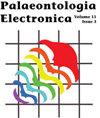美国新墨西哥州上三叠世的赤蠵龟和海龟的起源
IF 1.5
4区 地球科学
Q1 Earth and Planetary Sciences
引用次数: 12
摘要
Chinlechellys tenerteta是一种来自美国新墨西哥州东部Chinle群上三叠纪公牛峡谷组的海龟,在最近对四足目中海龟(Testudinata)的系统发育位置的研究中,这一点在很大程度上被忽视了。在这里,我们首次全面描述了中华鳖的形态,并重申了其对海龟肋骨形成复合模型的明确支持。我们还记录了Chinlechelys tenetersta中存在的独立肋骨,这让人想起了来自中国的晚三叠纪原龟Odontochelys semitetacea的肋骨,以及肋板,正如在复合模型下所预期的那样。这表明,如复合模型所建议的,肋和肋板骨形成的两阶段胚胎学模型大致对应于肋内和肋板初级骨化的形成,然后是肋板和肋板的后期真皮形成。我们对二叠纪非洲真诺龙是干龟的鉴定提出了质疑,并认为它是一种干酪类突触动物。我们不认为罗氏巴布亚龟是海龟的近亲。它更像是基部的普氏蜥脚亚目,尤其是伯勒克里普氏蜥。事实上,基于正确编码的特征状态的系统发育分析将罗氏Pappochelys rosinae定位在Sauropterygia中,作为扁齿龙的姐妹分类单元。Chinlechelys tenerteta的形态支持将Testudines放置在冠蜥外,作为一个基于背侧骨皮和颅骨顶部形态的从异足龙衍生而来的分类单元。Asher J.Lichtig。新墨西哥州自然历史与科学博物馆,美国新墨西哥州阿尔伯克基西北山路1801号,邮编87104。ajlichtig@gmail.comSpencer G.Lucas。新墨西哥州自然历史与科学博物馆,美国新墨西哥州阿尔伯克基西北山路1801号,邮编87104。spencer.lucas@state.nm.us本文章由计算机程序翻译,如有差异,请以英文原文为准。
Chinlechelys from the Upper Triassic of New Mexico, USA, and the origin of turtles
Chinlechelys tenertesta is a turtle from the Upper Triassic Bull Canyon Formation of the Chinle Group of eastern New Mexico, USA, which has largely been ignored in recent studies of the phylogenetic position of turtles (Testudinata) within the Tetrapoda. Here, we present the first comprehensive description of the morphology of Chinlechelys tenertesta and reaffirm its unequivocal support for the composite model of costal bone formation in turtles. We also document the presence in Chinlechelys tenertesta of separate ribs reminiscent of those of Odontochelys semitestacea, a Late Triassic prototurtle from China, and costal plates, as would be expected under the composite model. This indicates that the two-phase embryological model of costal and plastral bone formation approximately corresponds to the formation of the endochondal rib and plastral primary ossifications and then the later dermal formation of the plastral and costal plates, as is suggested by the composite model. We challenge the identification of Permian Eunotosaurus africanus as a stem turtle and instead suggest that it is a caseid synapsid. We do not consider Pappochelys rosinae to be a close relative of turtles. It more closely resembles the basal placodont sauropterygians, particularly Palatodonta bleekeri. Indeed, phylogenetic analysis based on correctly coded character states places Pappochelys rosinae in the Sauropterygia as the sister taxon of placodonts. The morphology of Chinlechelys tenertesta supports the placement of Testudines outside of crown Sauria, as a taxon derived from pareiasaurs based on the morphology of the dorsal osteoderms and skull roof. Asher J. Lichtig. New Mexico Museum of Natural History & Science, 1801 Mountain Road N. W., Albuquerque, New Mexico 87104, USA. ajlichtig@gmail.com Spencer G. Lucas. New Mexico Museum of Natural History & Science, 1801 Mountain Road N. W., Albuquerque, New Mexico 87104, USA. spencer.lucas@state.nm.us
求助全文
通过发布文献求助,成功后即可免费获取论文全文。
去求助
来源期刊

Palaeontologia Electronica
地学-古生物学
CiteScore
3.60
自引率
0.00%
发文量
20
审稿时长
>12 weeks
期刊介绍:
Founded in 1997, Palaeontologia Electronica (PE) is the longest running open-access, peer-reviewed electronic journal and covers all aspects of palaeontology. PE uses an external double-blind peer review system for all manuscripts. Copyright of scientific papers is held by one of the three sponsoring professional societies at the author''s choice. Reviews, commentaries, and other material is placed in the public domain. PE papers comply with regulations for taxonomic nomenclature established in the International Code of Zoological Nomenclature and the International Code of Nomenclature for Algae, Fungi, and Plants.
 求助内容:
求助内容: 应助结果提醒方式:
应助结果提醒方式:


